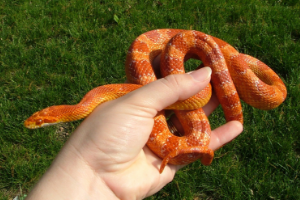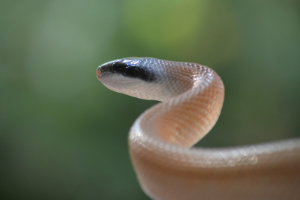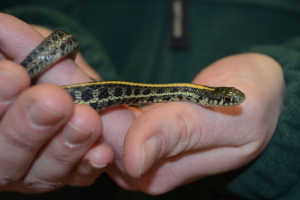 You either love them or hate them, but the fact of the matter is that we should be grateful that snakes are a part of our lives. There are about 3,000 species of snakes and they come in many different sizes and colors. Here in Ohio, there are 25 species native to the state. Out of those 25, only three are venomous.
You either love them or hate them, but the fact of the matter is that we should be grateful that snakes are a part of our lives. There are about 3,000 species of snakes and they come in many different sizes and colors. Here in Ohio, there are 25 species native to the state. Out of those 25, only three are venomous.
The Akron Zoo is currently the home of three different snake species; dumeril’s ground boas, green tree pythons, and cave dwelling rat snakes. Our green tree pythons are located at Curious Creatures inside the Komodo Kingdom building. Green tree pythons start out life either reddish brown or yellow and turn green as they grow. The two snakes in our habitat are named Yellow and Brown due to their coloring at birth and also happen to be sisters!
Our cave dwelling rat snakes are located in the bat building of Legends of the Wild. They tend to be about six feet in length and in going with their name, enjoy living in caves. They mainly feed on bats and eat their prey whole. As constrictor snakes, they coil their bodies around their prey to suffocate it rather than biting.
Snakes play an important role in the ecosystem. Since most snakes are in the middle of the food chain, if they were to disappear, many prey species would grow to unnaturally high populations and the animals that hunt snakes would struggle for food. Another thing that makes snakes so awesome is that some species, such as the timber rattlesnake, native to Ohio, eat ticks that potentially carry Lyme Disease. They can eat thousands of ticks per year! So we can thank them for taking care of such pests.
Besides being good for the ecosystem, snakes are just really amazing animals. Let’s take a look at some amazing facts about snakes!
•  Snakes are found on every continent except for Antarctica.
Snakes are found on every continent except for Antarctica.
• The digestive juices of snakes are so strong that they can digest bones and hair.
• Snakes shed their skin 3-6 times a year to make room for their growing bodies and get rid of parasites.
• Out of the 3000 species of snakes, 93% are nonvenomous.
• Snakes use their tongue to smell – that’s how they know if prey is near or if they are in danger by sensing and smelling what is around them.
•  Not all snakes live on land, some live in water. They are known as sea snakes.
Not all snakes live on land, some live in water. They are known as sea snakes.
• Snakes are cold-blooded and their body temperature can change with the temperature around them. Snakes in colder climates tend to hibernate in the winter months.
• A snake’s lower jaw is not connected to their skull the way a human jaw is. Because of this, they are able to open their mouth wider than their body to swallow prey whole
Next time you see a snake, hopefully you appreciate a little more how marvelous they truly are. Stop by your Akron Zoo to visit our snakes in the Curious Creatures and Legends of the Wild areas of the zoo.
By Sarah McClain, Communications Intern. Published July 16, 2019.
